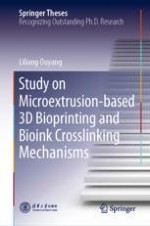2019 | OriginalPaper | Chapter
5. 3D Bioprinting of Thermal-Sensitive Bioink
Author : Dr. Liliang Ouyang
Published in: Study on Microextrusion-based 3D Bioprinting and Bioink Crosslinking Mechanisms
Publisher: Springer Singapore
Activate our intelligent search to find suitable subject content or patents.
Select sections of text to find matching patents with Artificial Intelligence. powered by
Select sections of text to find additional relevant content using AI-assisted search. powered by
